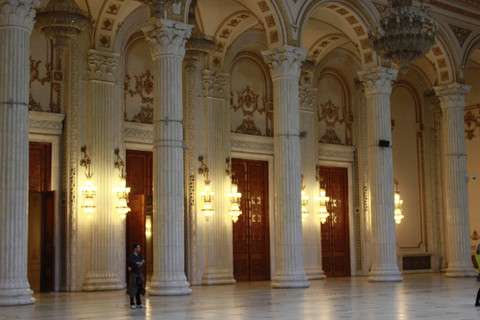
The hideous and overwhelming Palace of the Parliament building in Bucharest — even now, a guided tour lasts 2km but only takes in five percent of its rooms (Photo: Flickr/Matt Kieffer)
Theres’s a cliche that backroom negotiations at big summits sometimes feel as if they’re taking place in a “hall of mirrors.”
In the case of the 2008 Nato summit in Bucharest, where Ukraine was first offered the now red-hot issue of joining the Western alliance, it was also literally true.
-

Inside the endless hall of mirrors (Photo: Flickr/georgemoga)
The Nato summit was held in Nikolai Cecaescu’s People’s Palace (now the Palace of the Parliament). It’s a fairytale-turned-nightmare monument to the ego and self-promotion of the late Romanian dictator.
Cecaescu ended up being executed by his own people on Christmas Day 1989, indeed machine-gunned along with his wife by his own army, after a failed escape attempt to flee his own country by helicopter his condemnation at the hands of an ad hoc court.
The grisly outcome for Cecaescu was born of the resentment at his totalitarian rule that one guest at that summit, Vladimir Putin, may now care to reflect upon.
From the outside, Cecaeuscu’s Palace is a gigantic monstrosity in the wedding-cake style, with tiered layers, sitting atop the major promontory in the capital city.
On the inside, it was like being trapped inside a madman’s brain.
There’s a never-ending David Lynch meets MC Escher labyrinth-vortex of state banqueting rooms and ballrooms all leading on and on from one another, seemingly endlessly, and into infinity, and with no practical purpose whatsoever.
It made Stanley Kubrick’s Overlook Hotel in The Shining seem like a cosy bed-and-breakfast.
I was covering the summit for Agence France-Press as part of a team of around 12 reporters and photographers. My own personal news beat or patch was Macedonia — definitely the lowest rung of the ladder. One of the main thrusts of the summit was Afghanistan, with guest appearances from Hamid Karzhai and Putin himself.
I remember having my arm up to ask a question at the joint closing Putin-Karzai press conference until both arms hurt in their sockets. I never got called — which was a shame, as my question would have been: “President Putin, do you have any advice for Nato on how to invade and occupy Afghanistan?”
The short ones are the best ones. Embarrass Karzai, make Putin laugh — but also put him on the spot.
Meanwhile, Ukraine.
Professional historians and diplomats please correct me because, first, this is 14 years ago; second, I wasn’t covering this angle; and, third, even the official communique from the summit only listed it as item 23: but I can’t help recall how US president George W. Bush was pressing his fellow Nato delegates to give Ukraine and Georgia Nato membership.
The European end of the Nato equation (then led by Angela Merkel, Gordon Brown, Nicolas Sarkozy) pushed back, until the final communique offered them the aspiration of joining a compromise half-way house called the “Membership Action Plan”.
It was halfway down the summit declaration of 50 points, and it read — in full — as follows:
“Nato welcomes Ukraine’s and Georgia’s Euro-Atlantic aspirations for membership in Nato. We agreed today that these countries will become members of Nato. Both nations have made valuable contributions to Alliance operations. We welcome the democratic reforms in Ukraine and Georgia and look forward to free and fair parliamentary elections in Georgia in May. MAP [eds: membership action plan] is the next step for Ukraine and Georgia on their direct way to membership. Today we make clear that we support these countries’ applications for MAP. Therefore we will now begin a period of intensive engagement with both at a high political level to address the questions still outstanding pertaining to their MAP applications. We have asked Foreign Ministers to make a first assessment of progress at their December 2008 meeting. Foreign Ministers have the authority to decide on the MAP applications of Ukraine and Georgia.”
Fatefully, the words that probably still echo inside Putin’s head are those in the second sentence, that, “these countries will become members of Nato.” Putin invaded Georgia later that same year. The three-day summit ended on 8 April 2008, the Russian invasion of Georgia in August.
Fourteen years on, and he has invaded Ukraine too.
Was Bush right, to want to offer immediate membership? Or was Europe right, to offer it as a distant prospect?
I don’t know the answer to that — and there were certainly no answers on offer in that endless hall of mirrors.
Source: euobserver.com